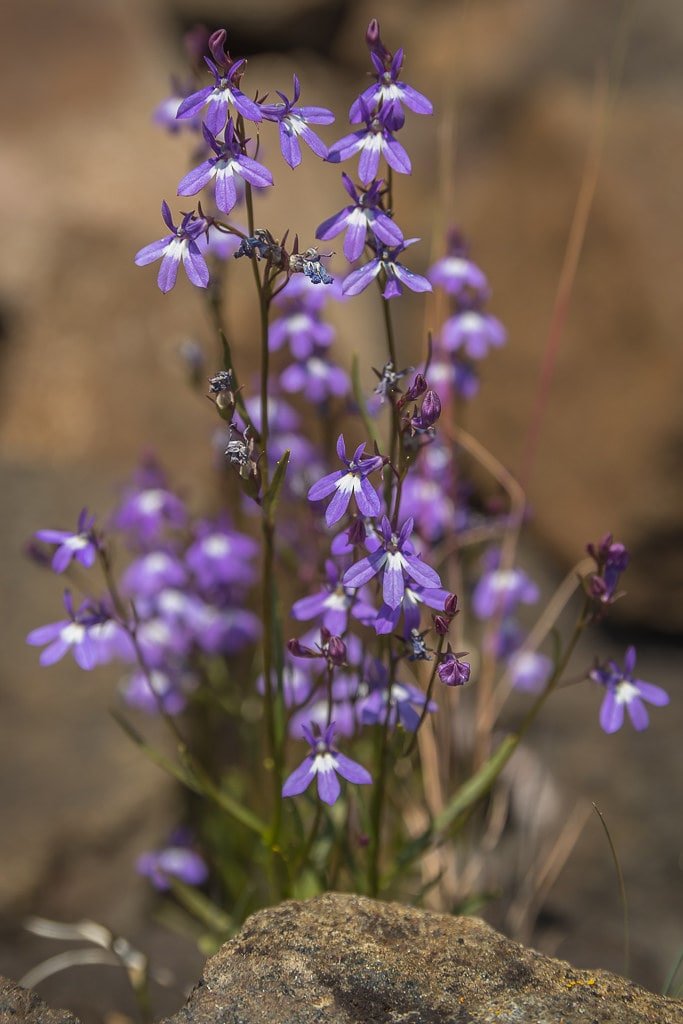Native Ontario Lobelias
Lobelias make delightful additions to native plant or natural gardens with their elegant, show-stopping flowers, ease of growth and high wildlife value. They are especially well known for their copious nectar reserves, making them an absolute must for native plant gardeners looking to attract hummingbirds. Cardinal flower seems to get most of the attention (its not hard to see why) but Ontario native plant gardeners have access to a range of other lobelias. There is a lobelia for almost any spot in your garden from sun to shade, dry to moist, meaning they can be used in a variety of garden types from rain gardens, prairie & meadow gardens, cottage gardens or woodland gardens alike.
Native Lobelias for Ontario Gardens:
Growing conditions: Sun to shade | 1.2m tall | moist to wet | Organically rich soils | Found in wet meadows, wetlands, forest edges, streambanks |
Cardinal flower is an iconic and highly desirable native plant that livens up rain gardens, woodland edges, cottage gardens and other moist areas. It is best known for its spires of scarlet flowers and ability to attract hummingbirds like no other plant. Easy and very rewarding to grow.
Appearance:
Cardinal flower forms dense rosettes of shiny, toothed leaves that often remain green through the winter. During the summer, tall flower stalks rise up from the rosettes, reaching about 1.2m tall in ideal conditions. These flower stalks bloom from the bottom up and are densely packed with vibrant, scarlet coloured flowers. Cardinal flower is especially well-suited to being grown in large clumps where its vertical stature and intense scarlet blooms can make a bold statement. Flowers mature into globular seed pods which persist to add winter interest. Although is thrives in shade, it blooms more abundantly in sunnier gardens. Cardinal flower has one of the longest bloom time of all the lobelias, lasting about 4-6 weeks.
How to grow:
Cardinal flower is very easy to grow in moist, fertile soils and is especially well-suited to rains gardens and moist, semi-shaded gardens. It will grow in full sun for full shade but grows best in filtered light. If planting it in full sun, ensure it has consistent moisture or it will suffer. It will tolerate most soils types, granted there is enough organic matter in the soil, but is very picky about moisture - do not let it dry out. It will tolerate brief periods of standing water such as during the spring snow melt. After seeds have been produced, the flowering stem will die back and new offsets will begin to grow from the base. The plant maintains a clumping habit and spreads mainly via seeds. Do not allow leaves or wood mulch to cover cardinal flowers evergreen rosettes over winter or they may die.
Being a short-lived perennial, it will eventually disappear from the garden if not allowed to self-seed. You can encourage its longevity in the garden by gently scratching up the ground around it so its seeds have a weed free spot to germinate. Its seeds need light to germinate so make sure they are surface-sown only.
Ecology:
Hummingbirds are the ideal pollinators for Cardinal flower due to their ability to reach down the throat of the flower to access the nectar. Butterflies will pollinate the flowers too but are much less effective. Deer don’t often browse this plant.
Growing conditions: Sun to part shade | 60cm tall | Average to dry | Loamy soils preferred but tolerates poor soils| Forests, forest edges, shorelines & meadows |
Indian tobacco brings a natural charm to woodland gardens and partly shades sites with its pastel violet blooms and attractive upright form. It is highly adaptable and ideal for adding beauty and wildlife value to dry, shady gardens or moist, sunny gardens alike.
Appearance:
Indian tobacco has an elegant and charming appearance. It reaches about 30-60cm tall, depending on growing conditions, and has an attractive upright form. From mid-summer into fall, flowering stems emerge from upper leaf axils, sporting light lavender to light violet-blue flowers. The flowers are small but really stand out when highlighted by filtered sunlight. Flowers fade to globular seed pods that persist into the winter months to extend seasonal interest. Indian tobacco is not often grown as a garden plant due to its small flowers but maybe we just need to get up close and appreciate plants for their subtle beauty and role in the ecosystem instead.
How to grow:
Indian tobacco is easy to grow in rich, loamy soils with adequate moisture. That being said, it is highly adaptable and will tolerate dry conditions and poor soil too. The more sun it receives, the more moisture it needs. The vigor and stature of this plant is highly dependable on growing conditions, reaching full size and bloom potential in rich, loamy soils that stay consistently moist. In dry, shady conditions it might max out at 30cm tall. The plant maintains a clumping habit and does not self-seed prolifically.
As an annual, it will persist in the landscape by self-seeding into open soil. Therefore, it likely won’t stay in one spot in your garden but rather, move around over time. To encourage its spread, gently scratch up the ground around it before it drops its seeds. Note that the seeds should be surface sown only due to their small size.
Ecology:
The flowers provide nectar for small bees. Deer typically don’t graze on this plant due to its toxicity.
Indian tobacco (Lobelia inflata)
Kalms Lobelia (Lobelia kalmii)
Growing conditions: Sun | 30cm tall | wet to consistently moist | Sandy, sandy-peat preferred |Wet sandy meadows, shorelines, bogs, seeps |
Kalms lobelia is a much under-appreciated native plant, likely being overlooked due to its small flowers and specific growing needs. However, what it lacks for in size, it makes up for by lending an elegant and refined look to the garden. It is best suited for pond edges or bog gardens or small water features where it can grow in consistent moisture.
Appearance:
Kalms Lobelia has a strong, upright form with slender stems and narrow leaves, lending a delicate appearance to the garden. In summer to early fall, the plant is adorned with pastel-blue to lavender flowers. These flowers are relatively large compared to the slender stems, creating a floating effect when viewed from a distance. Overall, this is a very compact and upright plant with a short stature meaning it can be ideal for small spaces. Flowers mature into small brown seed capsules. Kalms lobelia is often found growing in calcareous soil or cracks between limestone rocks, so consider giving it the same conditions in your garden to help it blend in naturally to its landscape.
How to grow:
Kalms lobelia thrives in wet, peaty-sandy soils in full sun. Calcareous soils are necessary. It will tolerate shallow, rocky soils if moisture is adequate. It cannot be allowed to dry out or it will suffer. Periods of standing water are tolerated. If happy, this plant will spread non-aggressively by seeds to form attractive masses. Competition from taller, more aggressive species is not tolerated so keep this in mind when choosing its location. An ideal choice for the bog gardens or the edges of ponds. It maintains a clumping habit and does not self-seed prolifically.
Ecology:
Bees and small butterflies are attracted to the flowers, as are hummingbirds who seek its nectar. Deer generally leave this plant alone.
Growing conditions: | Sun to shade | up to 1.2m tall| Moist to medium-dry | Most organically-rich soils | Wetlands, seeps, stream banks |
Blue lobelia is highly valued for the bold blue colour it lends to the garden - a colour that is hard to come across among wildflowers. Its long bloom time and ability to attract copious amounts of pollinators has earned it a well-deserved place in native plant gardens across its range.
Appearance:
Blue lobelia is a clump-forming, short-lived perennial that provides a strong vertical presence to the garden. It features evergreen basal rosettes with broad, dark-green, oval leaves. From the rosettes rise flowering stems adorned with relatively large (the largest flowers of all the lobelias), blue to blueish-purple flowers. They grace the upper stems in late summer and bloom for about 4-6 weeks. Flowers mature into ovoid seed capsules that add visual appeal through the winter months.
How to grow:
Blue lobelia thrives in part shade to part sun with rich, moist soil. Despite this, it will tolerate full sun if enough moisture is present. In the shade, it can tolerate slightly drier conditions - it is fairly adaptable. Ideal for damp, clay soils. Although plants can reach up to 1.2m in height, it will grow much shorter if grown in shadier and drier conditions.
This is a well-behaved, clump-forming plant and does not spread aggressively through seeds. It is a short-lived perennial but longer-lived than cardinal flower. Due to its short-lived nature, it may fade out of the garden over time. Gardeners may want to gently scratch up the ground around it when its seeds are ripe to encourage new generations of plants. After seeds are set, the flowering stem and its roots die back, encouraging new offsets to form at their bases.
Ecology:
The flowers are not only attractive to our eyes but also to bees, butterflies and hummingbirds that seek their nectar. Bumblebees seem to be the main visitors. The foliage is not eaten by deer.
Pale Spiked Lobelia (Lobelia spicata)
Growing conditions: Sun to part sun | 60cm tall | Average to dry | Sand, loam, clay | Prairies, savannas, open woods |
Pale spiked lobelia lends a touch of natural elegance to drier gardens that may not be suitable for the more moisture-loving lobelias such as Cardinal Flower. It is easy to grow and adaptable to a range of soil and moisture types.
Appearance:
Pale Spiked Lobelia is an unassuming plant with a slender, upright form. It typically blends in to surrounding foliage until summer when it bursts forth with elegant spires of white to light blue flowers. The delicate details in the flowers can be appreciated until the end of summer when the blooms start to fade. During this time, the lower leaves may turn yellow and fall off the stem, especially if it is a particularly dry season. Flowers mature into globular seed pods that persist into the cooler months to extend garden interest.
How to grow:
Pale spiked lobelia has a preference for full to part sun with a well-draining loamy soil. Despite this, it is quite adaptable to sandy or rocky ground and moist to dry conditions. It will tolerate drought once established. As a short-lived perennial, it will persist in the garden by self-seeding so don’t expect it to stay in one spot. Note that it is best planted tightly alongside companion plants, such as native grasses, otherwise it has a tendency to become floppy. The plant maintains a clumping habit and does not self-seed prolifically.
Ecology:
The small flowers are visited by equally small bees, butterflies and skippers. Hummingbirds may visit the flowers. Due to its toxic foliage, it is deer resistant.

















